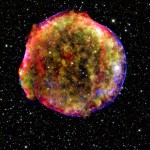It has been thought that we might already know all there is to know about how a stellar explosion occurs. Published Wednesday in the June edition of Nature, Caltech postdoctoral scholar Robert Quimby and his colleagues explained that there are indications of a new class of supernovae; a class 10 times brighter than any other exploding star studied. This indication was discovered when Robert Quimby, an astronomer at the California Institute of technology, found there were abnormalities with the elements in a handful of recently exploded stars.
What we know about how a supernova occurs is what astronomers call the chemical finger print. The chemical finger print of a supernova tells us what the supernova is made of, how far away the supernova is, and what happens when the supernova occurs. Looking at supernovae from a more generalized perspective astronomers have categorized them into being either white dwarf or massive star explosions with no hydrogen in their spectra, or they are exclusively massive stars that do display hydrogen lines.
What has been discovered with the 2005ap, 2006tf, 2006gy, 2008es and the SCP 06F6 supernovae is that they were very bright and hot with temperatures ranging between 10,000-20,000 degrees. The stars expanded very quickly at a rate of 10,000 kilometers per second and took way longer to fade than an average supernova. These supernovae contained absolutely no hydrogen.
Because of the lack of hydrogen found in these explosions astronomers believe there are two possible models that this bunch of outcast supernovae could be a part of, and if after further research they are found not to be one of the two models then these supernovae could be classified as a completely new type. The first model would be a pulsating star with a mass of about 90-130 times that of the sun. When it pulsates it blows off hydrogen free shells and after it has exhausted its fuel, it explodes causing extreme heating to the shells that it shed prior to explosion. This is what gives the supernova the ultra bright effect. The second possibility is that after the star explodes it creates a rotating magnetic field that interacts with the vast sea of charged particles filling space resulting in energy that heat up the previously blown off material creating a super luminous reaction.
Quimby and his colleagues just may have come across a class of supernovae that they already know all about. More research of the two possible models will, I’m sure, be explored further.
For further reading please visit:
http://www.physorg.com/news/2011-06-class-stellar-explosions.html
http://www.astronomynow.com/news/n1106/10SN/
http://www.cbc.ca/news/technology/story/2011/06/08/science-new-supernova.html

